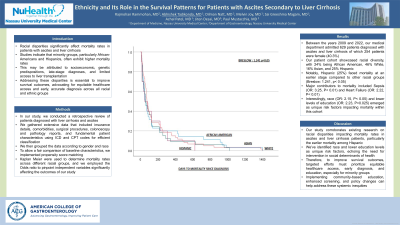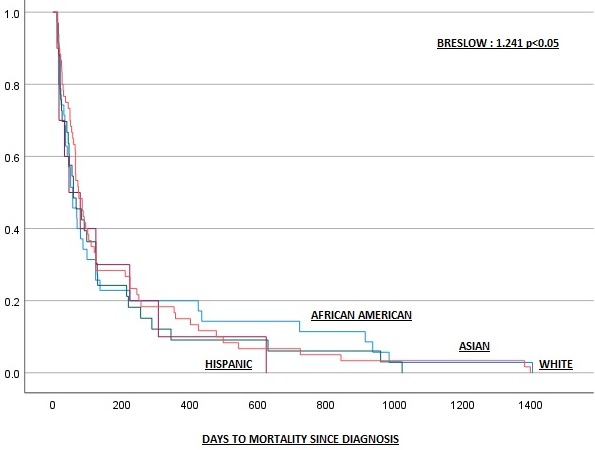Sunday Poster Session
Category: Liver
P0979 - Ethnicity and Its Role in the Survival Patterns for Patients With Ascites Secondary to Liver Cirrhosis
Sunday, October 22, 2023
3:30 PM - 7:00 PM PT
Location: Exhibit Hall

Has Audio
- AT
Abhishek Tadikonda, MD
Nassau University Medical Center
East Meadow, New York
Presenting Author(s)
Rajmohan Rammohan, MD, Dilman Natt, MD, Melvin Joy, MD, Sai Greeshma Magam, MD, Tulika Saggar, MD, Achal Patel, MD, Abhishek Tadikonda, MD, Jiten Desai, MD, Paul Mustacchia, MD, MBA
Nassau University Medical Center, East Meadow, NY
Introduction: Racial disparities significantly affect mortality rates in patients with ascites and liver cirrhosis. Studies indicate that minority groups, particularly African-Americans and Hispanics, often exhibit higher mortality rates. This may be attributed to socio-economic,genetic predispositions, late-stage diagnoses, and limited access to liver transplantation. Addressing these disparities is essential to improve survival outcomes, advocating for equitable healthcare access and early, accurate diagnosis across all racial and ethnic groups.
Methods: In our study, we conducted a retrospective review of patients diagnosed with liver cirrhosis and ascites. We gathered extensive data that included insurance details, comorbidities, surgical procedures, colonoscopy and pathology reports, and fundamental patient characteristics using ICD and CPT codes for efficient classification. We then grouped the data according to gender and race. To allow a fair comparison of baseline characteristics, we implemented propensity score matching. Kaplan Meier were used to determine mortality rates across different racial groups, and we employed the Odds ratio to pinpoint independent variables significantly affecting the outcomes of our study
Results: Between the years 2009 and 2022, our medical department admitted 629 patients diagnosed with ascites and liver cirrhosis of which 254 patients were female (40.3%). Our patient cohort showcased racial diversity, with 24% being African American, 46% White, 16% Asian, and 25% Hispanic. Notably, Hispanic (25%) faced mortality at an earlier stage compared to other racial groups (Breslow: 1.241, p< 0.05). Major contributors to mortality included Sepsis (OR: 3.25, P< 0.01) and Heart Failure (OR: 2.22, P< 0.01). Interestingly, race (OR: 2.15, P< 0.05) and lower levels of education (OR: 2.23, P=0.025) emerged as unique risk factors impacting mortality within this cohort
Discussion: Our study corroborates existing research on racial disparities impacting mortality rates in ascites and liver cirrhosis patients, particularly the earlier mortality among Hispanic. We've identified race and lower education levels as unique risk factors, echoing the need for intervention in social determinants of health. Therefore, to improve survival outcomes, targeted efforts must prioritize equitable healthcare access, early diagnosis, and education, especially for minority groups. Implementing community-based education, enhanced screening, and policy changes can help address these systemic inequities

Disclosures:
Rajmohan Rammohan, MD, Dilman Natt, MD, Melvin Joy, MD, Sai Greeshma Magam, MD, Tulika Saggar, MD, Achal Patel, MD, Abhishek Tadikonda, MD, Jiten Desai, MD, Paul Mustacchia, MD, MBA. P0979 - Ethnicity and Its Role in the Survival Patterns for Patients With Ascites Secondary to Liver Cirrhosis, ACG 2023 Annual Scientific Meeting Abstracts. Vancouver, BC, Canada: American College of Gastroenterology.
Nassau University Medical Center, East Meadow, NY
Introduction: Racial disparities significantly affect mortality rates in patients with ascites and liver cirrhosis. Studies indicate that minority groups, particularly African-Americans and Hispanics, often exhibit higher mortality rates. This may be attributed to socio-economic,genetic predispositions, late-stage diagnoses, and limited access to liver transplantation. Addressing these disparities is essential to improve survival outcomes, advocating for equitable healthcare access and early, accurate diagnosis across all racial and ethnic groups.
Methods: In our study, we conducted a retrospective review of patients diagnosed with liver cirrhosis and ascites. We gathered extensive data that included insurance details, comorbidities, surgical procedures, colonoscopy and pathology reports, and fundamental patient characteristics using ICD and CPT codes for efficient classification. We then grouped the data according to gender and race. To allow a fair comparison of baseline characteristics, we implemented propensity score matching. Kaplan Meier were used to determine mortality rates across different racial groups, and we employed the Odds ratio to pinpoint independent variables significantly affecting the outcomes of our study
Results: Between the years 2009 and 2022, our medical department admitted 629 patients diagnosed with ascites and liver cirrhosis of which 254 patients were female (40.3%). Our patient cohort showcased racial diversity, with 24% being African American, 46% White, 16% Asian, and 25% Hispanic. Notably, Hispanic (25%) faced mortality at an earlier stage compared to other racial groups (Breslow: 1.241, p< 0.05). Major contributors to mortality included Sepsis (OR: 3.25, P< 0.01) and Heart Failure (OR: 2.22, P< 0.01). Interestingly, race (OR: 2.15, P< 0.05) and lower levels of education (OR: 2.23, P=0.025) emerged as unique risk factors impacting mortality within this cohort
Discussion: Our study corroborates existing research on racial disparities impacting mortality rates in ascites and liver cirrhosis patients, particularly the earlier mortality among Hispanic. We've identified race and lower education levels as unique risk factors, echoing the need for intervention in social determinants of health. Therefore, to improve survival outcomes, targeted efforts must prioritize equitable healthcare access, early diagnosis, and education, especially for minority groups. Implementing community-based education, enhanced screening, and policy changes can help address these systemic inequities

Figure: Impact of Race on survival outcome in liver cirrhosis patients with ascities
Disclosures:
Rajmohan Rammohan indicated no relevant financial relationships.
Dilman Natt indicated no relevant financial relationships.
Melvin Joy indicated no relevant financial relationships.
Sai Greeshma Magam indicated no relevant financial relationships.
Tulika Saggar indicated no relevant financial relationships.
Achal Patel indicated no relevant financial relationships.
Abhishek Tadikonda indicated no relevant financial relationships.
Jiten Desai indicated no relevant financial relationships.
Paul Mustacchia indicated no relevant financial relationships.
Rajmohan Rammohan, MD, Dilman Natt, MD, Melvin Joy, MD, Sai Greeshma Magam, MD, Tulika Saggar, MD, Achal Patel, MD, Abhishek Tadikonda, MD, Jiten Desai, MD, Paul Mustacchia, MD, MBA. P0979 - Ethnicity and Its Role in the Survival Patterns for Patients With Ascites Secondary to Liver Cirrhosis, ACG 2023 Annual Scientific Meeting Abstracts. Vancouver, BC, Canada: American College of Gastroenterology.
